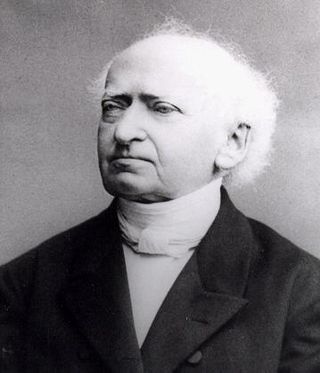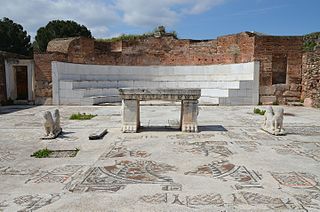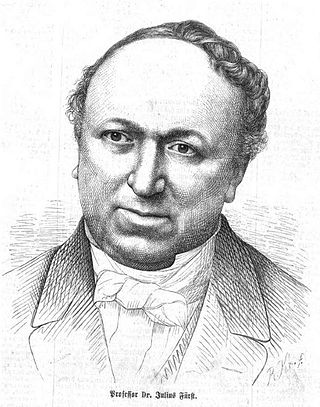Related Research Articles

Messianic Judaism is a syncretic Abrahamist new religious movement or sect that considers itself Jewish. Many Jews and Jewish authority figures, both in the United States and Israel, consider it a part of Evangelical Christianity.

Franz Delitzsch was a German Lutheran theologian and Hebraist. Delitzsch wrote many commentaries on books of the Bible, Jewish antiquities, Biblical psychology, as well as a history of Jewish poetry, and works of Christian apologetics. Today, Delitzsch is best known for his translation of the New Testament into Hebrew (1877), and his series of commentaries on the Old Testament published with Carl Friedrich Keil.

James Strong was an American academic, biblical scholar, lexicographer, Methodist theologian and professor, best known for being the creator of Strong's Concordance.
The Jewish apocrypha are religious texts written in large part by Jews, especially during the Second Temple period, not accepted as sacred manuscripts when the Hebrew Bible was canonized. Some of these books are considered sacred in certain Christian denominations and are included in their versions of the Old Testament. The Jewish apocrypha is distinctive from the New Testament apocrypha and Christian biblical apocrypha as it is the only one of these collections which works within a Jewish theological framework.

The Hebrew Christian movement of the 19th and early 20th centuries consisted of Jews who converted to Christianity, but worshiped in congregations separate from denominational churches. In many cases, they retained some Jewish practices and liturgy, with the addition of readings from the Christian New Testament. The movement was incorporated into the parallel Messianic Jewish movement in the late 1960s.
The Institutum Judaicum was a special academic course for Protestant theologians who desired to prepare themselves for missionary work among the Jews.

God-fearers or God-worshippers were a numerous class of Gentile sympathizers to Hellenistic Judaism that existed in the Greco-Roman world, which observed certain Jewish religious rites and traditions without becoming full converts to Judaism. The concept has precedents in the proselytes of the Hebrew Bible.
Jon Douglas Levenson is an American Hebrew Bible scholar who is the Albert A. List Professor of Jewish Studies at the Harvard Divinity School.
Old Testament theology is the branch of Biblical theology that seeks theological insight within the Old Testament or Hebrew Bible. It explores past and present theological concepts as they pertain to God and God's relationship with creation. While the field started out as a Christian endeavor written mostly by men and aimed to provide an objective knowledge of early revelation, in the twentieth century it became informed by other voices and views, including those of feminist and Jewish scholars, which provided new insights and showed ways that the early work was bound by the perspectives of their authors.
Bernhard Pick was a German-American Lutheran pastor and scholar.

Julius Fürst, born Joseph Alsari, was a Jewish German orientalist and the son of noted maggid, teacher, and Hebrew grammarian Jacob Alsari. Fürst was a distinguished scholar of Semitic languages and literature. During his years as professor in the department of oriental languages and literature at the University of Leipzig (1864–1873), he wrote many works on literary history and linguistics.
Herschell E. Filipowski, also known as Tzvi Hirsh Filipowski, was a Lithuanian-born British Jewish Hebraist, editor, mathematician, linguist and actuary.
Gabriel Fabricy is a French biblical scholar, archaeologist and dominican friar.
Ferdinand Christopher Ewald was a Bavarian-born English clergyman and missionary.
Henry Poper (1813–1870) was a German-born Jewish convert to Christianity, a clergyman of the Church of England, and a missionary to Jews.
Joachim Neumann (1778/79–1865) was a noted German educator and Hebraist, and a convert to Christianity from Judaism.
Samuel Israeli of Morocco was a supposed Jewish convert to Christianity who lived at the close of the 11th century. The details of his life and the works ascribed to him have been shown to be likely 15th century forgeries.
Alfonso Buenhombre was a Dominican missionary and polemicist.
AndreaDe Monte was a Moroccan Jewish convert to Christianity and missionary to the Jews at Rome.

Paulus Weidner von Billerburg was a Jewish convert to Christianity, a medical doctor, and professor of Hebrew at the University of Vienna.
References
 This article incorporates text from a publication now in the public domain : Jacobs, Joseph; Lipkind, Goodman (1905). "Newman, Selig". In Singer, Isidore; et al. (eds.). The Jewish Encyclopedia . Vol. 9. New York: Funk & Wagnalls. p. 294.
This article incorporates text from a publication now in the public domain : Jacobs, Joseph; Lipkind, Goodman (1905). "Newman, Selig". In Singer, Isidore; et al. (eds.). The Jewish Encyclopedia . Vol. 9. New York: Funk & Wagnalls. p. 294. This article incorporates text from this source, which is in the public domain : Fairchild, J. H. (1877). "Newman, Selig". In Strong, James; McClintock, John (eds.). Cyclopaedia of Biblical, Theological and Ecclesiastical Literature . Vol. 7. New York: Harper & Brothers. pp. 18–19.
This article incorporates text from this source, which is in the public domain : Fairchild, J. H. (1877). "Newman, Selig". In Strong, James; McClintock, John (eds.). Cyclopaedia of Biblical, Theological and Ecclesiastical Literature . Vol. 7. New York: Harper & Brothers. pp. 18–19.
Citations
- 1 2 Morais, Henry Samuel (1880). Eminent Israelites of the Nineteenth Century: A Series of Biographical Sketches. Philadelphia: E. Stern & Company. p. 252–255.
- ↑ "Philo-Judæn Society". The Times . No. 13222. London. 9 March 1827. p. 3.
- 1 2 Fairchild, J. H. (1877). "Newman, Selig". In Strong, James; McClintock, John (eds.). Cyclopaedia of Biblical, Theological and Ecclesiastical Literature . Vol. 7. New York: Harper & Brothers. pp. 18–19.
- ↑ Goldman, Israel M. (1967). "Henry W. Schneeberger: His Rôle in American Judaism". American Jewish Historical Quarterly. 57 (2). Johns Hopkins University Press: 152–190. ISSN 0002-9068. JSTOR 23876073.
- ↑ Sarna, Jonathan D. (1981). "The American Jewish Response to Nineteenth-Century Christian Missions". The Journal of American History. 68 (1). Oxford University Press: 35–51. doi:10.2307/1890901. ISSN 0021-8723. JSTOR 1890901.
- ↑ Sarna, Jonathan D. (1980). "The Freethinker, the Jews, and the Missionaries: George Houston and the Mystery of 'Israel Vindicated'". AJS Review . 5. Cambridge University Press: 101–114. doi:10.1017/S036400940000009X. ISSN 0364-0094. JSTOR 1486455. S2CID 162556147.